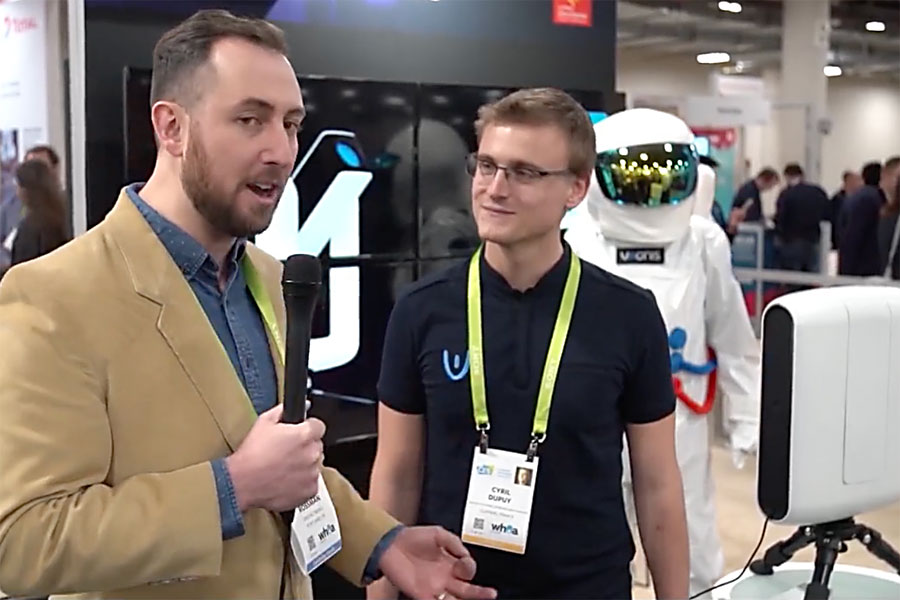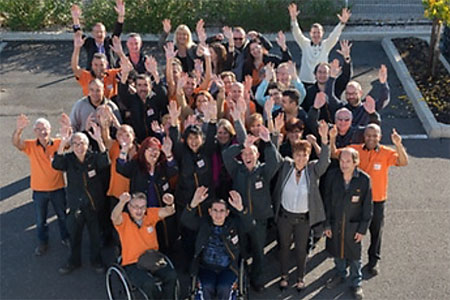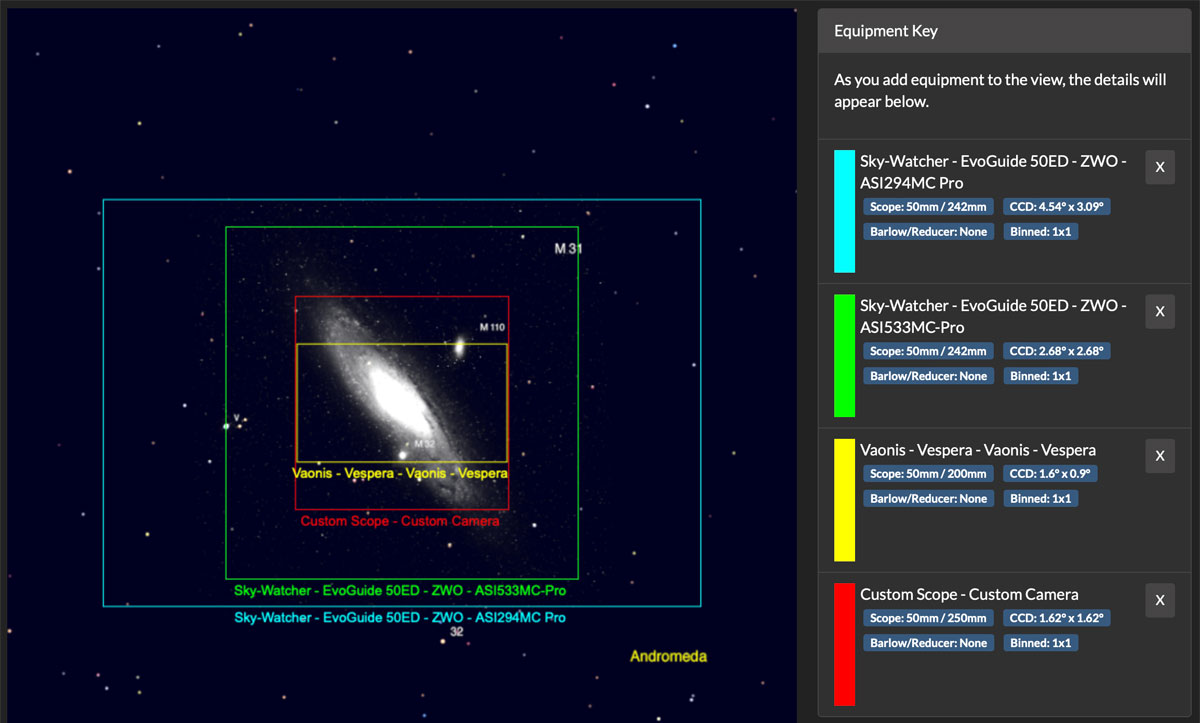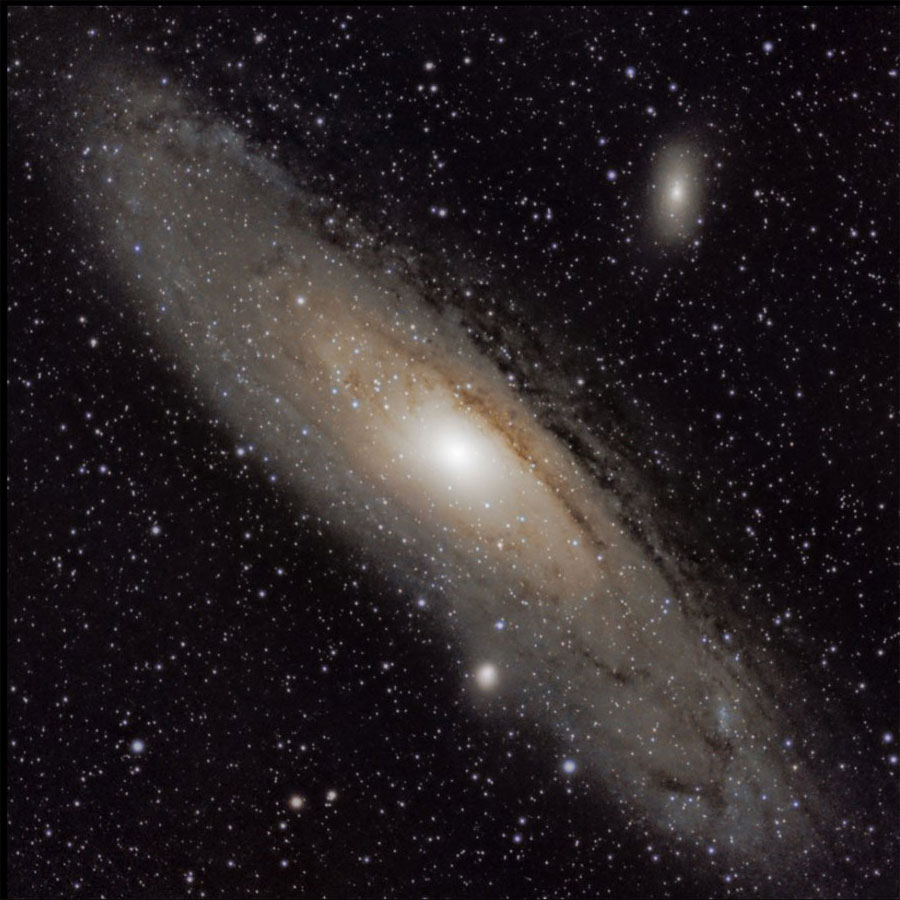Vaonis Vespera Pro - Information (2" Refractor)
Introduction | About Vespera Pro | Look | Sensor, Pixel Data, Field of View, Image Size (Pixels) | Visited Sky Objects | First Experiences and Photos | Photo Attempts | First Conclusions | Links || Appendix: Technical Data | Appendix: Comparison of the Vaonis Vespera, Vaonis Vespera Pro, and the Unistellar eVscope (2) | Appendix: Look | Appendix Photos
On this page, I provide some information about my future electronic 2" refractor telescope Vaonis Vespera Pro 50 mm/250 mm (f/5). I pre-ordered it on June 14, 2023; shipment is promised for May 2024.
>> UPS reported a delivery on May 3, 2024, but I delayed it to May 6, 2024.
Note:
- For further information about Vaonis see the Vaonis Website, the Vespera Pro product page there, and page Vaonis Vespera - Information on this site.
- Some of the photos were taken from the Vaonis Website. Vaonis granted me the permission to use their photos on my Website.
Introduction

Photo: Vaonis Vespera Pro (July 2023; prototype???)
Vespera Pro is an update of the Vespera electronic telescope from the French company Vaonis. It has been available for pre-order on the Vaonis Website since mid-June 2023. Delivery of the telescope was planned for the first pre-orders in May 2024 and appears to be taking place. Later pre-orders are to be delivered from July 2024 on; the price has also been gradually increased.
In the following, I try to collect information about the Vespera Pro as far as I could get them from the Vaonis Vespera Pro product page or other sources.
About Vespera Pro
What is Vespera Pro?
Vespera was meant to become a small and affordable version of Stellina. The Vespera Pro is an evolution of the Vespera with some changes from the original Vespera (sensor, focal length, aperture ratio).
Thus, it is also a refractor, the lens again is a quadruplet with 50 mm aperture (like binoculars), but with a focal length of 250 mm (aperture ratio f/5) and with a specially designed "pro" field corrector.
The Vespera Pro uses a Sony IMX676 Starvis 2 sensor with a resolution of 3536 x 3536 pixels (12.5 MP). This delivers a field of view of 1.6° x 1.6°, which makes also the Vespera Pro a small rich field telescope. Its image scale or sampling rate is 1.65"/pixel, which is much better than that for the original Vespera (2.99"/pixel). With a weight of 5 kg and a height of 40 cm, the Vespera Pro has remained light and compact, making it an ideal travel telescope. The internal battery lasts for 11 hours, which is quite a long time. I decided to go for the simple package without an additional high tripod (2000 EUR instead of 2500 EUR).
Here are some technical data:
Technique |
Optics |
Mount |
||
|
Sensor
|
Other
|
More on this telescope on the Vespera Pro product page.
Why Did I Opt for the Vaonis Vespera Pro?
Especially since the introduction of the Mosaic mode, I am very fond of my Vespera. The appeal of the Vespera Pro for me was that the new sensor has a higher resolution and its field of view is 1.6° square. This makes the Vespera Pro almost a rich-field telescope, especially in mosaic mode (maximum 2.6° squared).
Who is Behind the Vaonis Vespera Pro?
 |
 |
|
Cyril Dupuy, founder and CEO of Vaonis, in an interview |
The manufacturer's team |
(Photos from the Vaonis-Website (EN); permission for use granted)
Vaonis is a French company based in Montpellier, France, that designs and manufactures telescopes and accessories. The company was founded in 2016 by Cyril Dupuy, a young start-up entrepreneur, after obtaining his Bachelor in Optics and Aerospace. From his experience of using different telescopes with complex installation, long user guides and recurring breakdowns, he imagined and designed Stellina, the world's first all-in-one telescope connected to a mobile app. Vaonis' products are designed and developed by specialists in optics, mechanics, electronics, material and ergonomics, giving special attention to its design, quality and safety. (From the Vaonis Website, adapted)
Look
In preparation
Here I will present photos of the unboxing, the telescope itself, and its first accessories.
Sensor, Pixel Data, Field of View, Image Size (Pixels)
The Vespera Pro uses the new sensor Sony IMX676 (CMOS; Starvis 2), with a used pixel size of about 12.5 megapixels, or 3536 x 3536 pixels (H/V). The pixel size is 2.0µm (quadratic pixels).
With this, all sizes are known to calculate the field of view of the Vespera, which amounts to 1.6° x 1.6°.
The following table shows the Vespera Pro, Vespera, eVscope, and eVscope 2 in comparison with my current telescope (plus the C8 that I owned) tubes at a selection of cameras that I own(ed):
Field of View |
|||||||||
| Telescope | Reducer | Focal Length |
Aperture | f | ASI224MC* | ASI294MC | ASI462MC | Atik Infinity* | Remarks |
| PS 72/432 | --- | 432 | 72 | 7 | 0.65° x 0.48° | 2.54° x 1.73° | 0.74° x 0.42° | 1.19° x 0.89° | The largest FOV of my tubes |
| C5 | --- | 1250 | 127 | 10 | 0.22° x 0.17° | 0.88° x 0.60° | 0.26° x 0.15° | 0.41° x 0.31° | FOV like C8 with reducer |
| C5 | f/6.3 | 787.5 | 127 | 6.3 | 0.36° x 0.17° | 1.40° x 0.95° | 0.41° x 0.23° | 0.65° x 0.49° | FOV a little smaller as with TLAPO1027 |
| C8* | --- | 2032 | 203 | 10 | 0.14° x 0.1° | 0.54° x 0.37° | 0.16° x 0.09° | 0.25° x 0.19° | The smallest FOV |
| C8* | f/6.3 | 1280 | 203 | 6.3 | 0.22° x 0.16° | 0.86° x 0.58° | 0.25° x 0.14° | 0.4° x 0.3° | FOV like C5 |
| TLAPO1027 | --- | 714 | 102 | 7 | 0.39° x 0.29° | 1.54° x 1.05° | 0.45° x 0.26° | 0.72° x 0.54° | FOV a little larger than for C5 with reducer |
| in Degrees | in Minutes | ||||||||
| eVscope* | --- | 450 | 114 | 4 | 0.61° x 0.46° | 36.7' x 27.6' | Same sensor as ASI224: Sony IMX224 | ||
| eVscope 2* | --- | 450 | 114 | 4 | 0.78° x 0.57° | 47' x 34' | New sensor: Sony IMX347 | ||
| Vespera | 200 | 50 | 4 | 1.6° x 0.9° | 96' x 54' (ca.) | Same sensor as ASI462: Sony IMX462 | |||
| Vespera Pro | 250 | 50 | 5 | 1.6° x 1.6° | 96' x 96' (ca.) | New sensor: Sony IMX676 | |||
*) No longer in my possession
Image Size (Pixels)
Sony's IMX676 sensor can be used with 3536 x 3536 pixels (12.5 MP; recommendation by Sony). However, the resultig photos may often be somewhat smaller because they are automatically cropped, probably in response to field rotation.
Field of View (FOV)
The Vespera Pro has double the FOV of the Vespera (calculated with astronomy.tools):
Vespera Pro in red (Custom Camera)
Simulation of the FOV by Vaonis, rotated for 180° (product page for Vespera Pro):
And another comparison with the Sky-Watcher EvoGuide 50ED (calculated with astronomy.tools):

Vespera Pro in red (Custom Camera)
Visited Sky Objects
In preparation
First Experiences and Photos
In preparation
First Conclusions
In preparation
Links
- Vaonis: vaonis.com/fr (FR), vaonis.com (EN)
- Vespera Pro product page: https://vaonis.com/vespera-pro
- See also my page offering Astronomy Links.
Appendix: Technical Data for the Vaonis Vespera Pro
Hardware
- Magnification: 40 x optical???
- Maximum magnitude: up to 16 mag in good sky
- Aperture: 50 mm
- Focal length: 200 mm
- Focal ratio: 1:5
- Motorized Alt-AZ mount
- Weight: 5 kg
- Size: 15 x 8 x 3.5 in (40 x 20 x 9 cm)
Bag
- Same as the one for the Vespera (optional)
Electronics
- Sensor model: Sony IMX676 (CMOS, Starvis 2) - for details see further below
- Battery life: up to 11 hours (internal battery)
- Wireless connectivity: Wifi for smartphone or computer control and GPS access (no GPS inside)
Smarts
- Autonomous field detection
- Fully automated star alignment procedure
- Automated pointing
- Automated celestial tracking
- Intelligent image processing
Sensor Data
- Sony Starvis 2 IMX676 color CMOS sensor - 12.5 MPixels
- Sensor size: 1/1.6", 3536 x 3536 pixels
- Pixel size: 2.0µm x 2.0µm
- Read noise: < 0.5e-???
Appendix: Comparison of the Vaonis Vespera, Vaonis Vespera Pro, and the Unistellar eVscope (2)
| Vespera | Vespera Pro | eVscope | eVscope 2 | |
| Weight | 5 kg (11 lbs) | 5 kg (11 lbs) | 9 kg (19.8 lbs) including tripod |
9 kg (19.8 lbs) including tripod |
| Height | 40 cm (15 in) | 40 cm (15 in) | 65 cm (25.5 in) | 65 cm (25.5 in) |
| Width | 20 cm (8 in) | 20 cm (8 in) | 23 cm (9 in) | 23 cm (9 in) |
| Depth | 9 cm (3.5 in) | 9 cm (3.5 in) | n.a. | n.a. |
| Telescope type | Refractor | Refractor | Reflector (Newtonian) | Reflector (Newtonian) |
| Lens/Mirror | Apochromatic Quadruplet | Apochromatic Quadruplet | mirror | mirror |
| Lens/Mirror special features | Extra low dispersion S-FPL52 equivalent (ULD) with lanthanum glass | Extra low dispersion S-FPL52 equivalent (ULD) with lanthanum glass | BK7 glass mirror | BK7 glass mirror |
| Aperture | 50 mm | 50 mm | 112 or 114 mm | 112 or 114 mm |
| Focal length | 200 mm | 250 mm | 450 mm | 450 mm |
| Focal ratio | F/4 | F/5 | F/4 | F/4 |
| Field of view | 1.6° x 0.9° | 1.6° x 1.6° | 0.61° x 0.46° (36.7' x 27.6') | 0.78° x 0.57° (47' x 37') |
| Mount | Alt-azimuth | Alt-azimuth | Alt-azimuth | Alt-azimuth |
| Field derotator | no, done in software | no, done in software | no, done in software | no, done in software |
| Image sensor | Sony IMX462 | Sony IMX676 | Sony IMX224 | Sony IMX347 |
| Resolution | 1920 x 1080 (2MP) | 3536 x 3536 (12.5MP) | 1280 x 960 (1,2 MP) / 2560 x 1920 (2,4 MP) scaled (EV mode) | 2048 x 1536 (3,2 MP), 3200 x 2400 (7,7 MP) scaled (EV mode) |
| Sensor size | 1/2.8" | 1/1.6" | 1/3" | 1/1.8" |
| File formats | JPEG, TIFF, FITS (TIFF/FITS in 16 bits) | JPEG, TIFF, FITS (TIFF/FITS in 16 bits) | PNG | PNG |
| USB port (pictures download) | no (with Wi-Fi) | no (with Wi-Fi) | no (with Wi-Fi) | no (with Wi-Fi) |
| Autofocus | yes | yes | no | no |
| Light pollution filter | Optional | Optional | no, done in software | no, done in software |
| Dew control | Yes as soon as the (optional) sensor is installed | yes | no | no |
| Temperature/humidity sensor | Optional | yes | no | no |
| Battery type | Integrated | Integrated | Integrated | Integrated |
| Battery life | up to 8 h | up to 11 h | up to 10 h | up to 10 h |
| Water resistance | IP43 | IP43??? | n.a. | n.a. |
| Multi user mode | up to 8 users* | up to 8 users | yes (number unknown) | yes (up to 10 users) |
| Number of objects in data base | 300+ (July 2023) 4000 (extended) |
300+ (July 2023) 4000 (extended) |
> 5000, > 120 with descriptions | > 5000, > 120 with descriptions |
| Object access via coordinates | yes | yes | yes | yes |
| Solar pointing | yes (with optional filter) | yes (with optional filter) | yes (with optional filter) | yes (with optional filter) |
| Connected battery | possible | possible | possible | possible |
| Connection to Wi-Fi hotspots | no | no | no | no |
| Scheduling of observations | yes | yes | no | no |
| Expert mode (camera control) | yes | yes | manual pre-processing (brightness, background) already available in 2020 | manual pre-processing (brightness, background) |
| HDR Image processing | yes | yes | no | no |
| Pictures stocking in the app | up to 100 images | up to 100 images | no, on the smartphone depending on its memory size | no, on the smartphone depending on its memory size |
| Mosaic mode | 3.2° x 1.8° (4 x sensor field) at maximum, up to 8 MP | 2.6° x 2.6° at maximum, up to 32 MP | no | no |
Appendix: Look
In preparation
Here I will present photos of the Vespera Pro that Vaonis published.
Photo: Vaonis Vespera Pro (July 2023; prototype???)
Appendix: Photos
In preparation
Here I will present photos taken with the Vespera Pro that Vaonis published.
| 01.05.2024 |

